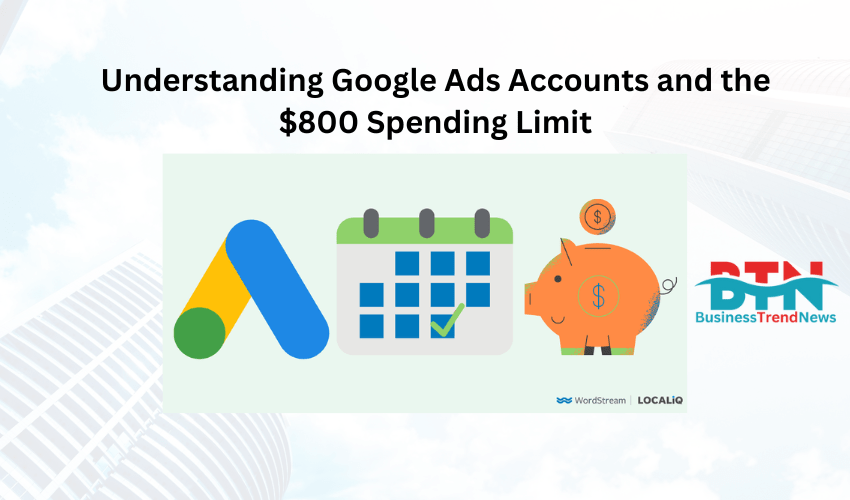![]()
Introduction
Google Ads is a robust online advertising platform that allows businesses and individuals to promote their products and services across Google’s vast network, including the search engine, YouTube, Gmail, and partner websites. It is an essential tool for businesses aiming to increase online visibility, drive traffic, and convert leads into customers. In this extensive guide, we’ll explore the fundamental aspects of a Google Ads account, focusing particularly on the notion of spending limits — such as the $800 limit that many advertisers encounter.
What is Google Ads?
Google Ads, formerly known as Google AdWords, is a pay-per-click (PPC) advertising platform. It operates on an auction model where advertisers bid on specific keywords related to their business. When someone searches for those keywords, the ad may appear, either on the search results page or on Google’s partner websites. The ads are typically shown at the top or bottom of the search results page, and advertisers are charged only when a user clicks on the ad — hence the term “pay-per-click.”
The Google Ads platform offers several types of campaigns to suit different marketing objectives:
- Search Campaigns: Text-based ads that appear on Google Search results when users search for specific keywords.
- Display Campaigns: Visual ads displayed across Google’s vast Display Network, which includes millions of websites and apps.
- Video Campaigns: Ads that appear on YouTube and other video partners.
- Shopping Campaigns: Product-based ads that show up in Google Shopping results.
- App Campaigns: Designed to drive downloads and engagement for mobile apps.
- Local Campaigns: Designed to drive foot traffic to physical locations.
The flexibility of the platform allows businesses to target specific audiences, control their advertising budgets, and measure the effectiveness of their campaigns through real-time analytics and reporting.
Creating a Google Ads Account
Creating a Google Ads account is a straightforward process. Users need a Google account to get started. After setting up the account, businesses can start by choosing their advertising goals, defining their target audience, and selecting keywords relevant to their products or services. Google also provides automated suggestions for ad placements, bids, and keywords, which can be particularly useful for beginners.
Once the account is set up, the real work begins — crafting compelling ad copy, selecting the right keywords, and setting up proper tracking to measure conversions and ROI (Return on Investment).
The Role of Budgets and Bidding in Google Ads
Google Ads operates on a bidding system where advertisers set a daily budget and decide on the maximum amount they’re willing to pay per click (CPC — cost per click) or per impression (CPM — cost per thousand impressions).
- Daily Budget: This is the average amount you’re willing to spend each day on your campaign. Google Ads might exceed your daily budget on certain days, but it will balance out by spending less on other days to ensure that the average daily spend stays on target over the course of a month.
- Bidding Strategies: Google Ads offers several bidding strategies depending on your goals:
- Manual CPC: Allows advertisers to manually set the maximum CPC for their ads.
- Maximize Clicks: Automatically sets bids to get as many clicks as possible within the set daily budget.
- Target CPA (Cost Per Acquisition): Automatically sets bids to help get as many conversions as possible at the set target CPA.
- Target ROAS (Return on Ad Spend): Automatically adjusts bids to maximize the return on ad spend based on the set target.
Effective budget management and bidding strategies are essential for optimizing the performance of your Google Ads campaigns. However, budget constraints are also important, particularly for small businesses or those working with a limited marketing budget.
What is the Google Ads Spending Limit?
The Google Ads spending limit is a pre-set amount that caps how much you can spend on your advertising campaigns. It helps advertisers manage their expenses and prevents unexpected large charges, especially in the early stages of a campaign. Spending limits are often based on the account’s billing threshold or credit card limits.
An $800 spending limit is a common threshold in many accounts, especially new ones or those set up with specific billing structures. This limit means that once you’ve accrued $800 in ad spend, your campaigns may be paused, or you may be charged, depending on the billing settings of the account.
Why is There an $800 Spending Limit?
The spending limit exists to protect both advertisers and Google. Here’s why it matters:
- Protection Against Overspending: For many businesses, controlling advertising costs is crucial. Without a spending limit, a high-performing ad campaign could quickly drain a company’s budget. A spending limit of $800 allows advertisers to manage their budget more effectively by capping spending.
- Managing Billing Cycles: For advertisers using automatic payments, Google Ads will charge your payment method once you’ve accrued a certain amount in costs — often around $800, depending on the account’s history. This helps ensure that bills are manageable and not too high. Once the threshold is reached, a charge is made, and the limit may reset for the next billing cycle.
- Building Trust with New Accounts: When a new Google Ads account is created, the platform sets a relatively low spending limit, like $50 or $100. As you pay off these charges, your limit increases gradually — up to $800 or more. This process helps Google build trust with new advertisers and ensures that the payment method is reliable.
- Improved Control and Monitoring: With a set spending limit, advertisers can better monitor the performance of their ads. It’s easier to evaluate what’s working and what isn’t without the fear of overspending. If a campaign isn’t performing as expected, it can be adjusted before more money is spent.
How Does the $800 Spending Limit Work?
Once you reach the $800 spending threshold, your Google Ads account will be charged, or your campaigns may be paused until the payment is made. Here’s a closer look at how it works:
- Automatic Payments: If your account is set to automatic payments, Google will charge your payment method when your account reaches the $800 threshold. After the charge is processed, your campaigns will continue running until the next threshold is met.
- Manual Payments: If you’ve chosen manual payments, you’ll need to add funds to your Google Ads account. Once the $800 limit is reached, your ads may stop running until additional funds are added.
- Billing Thresholds: Initially, your billing threshold may be lower, but as you continue to pay off your Google Ads charges, the threshold will increase incrementally. The $800 limit is a common ceiling for many established accounts.
- Monitoring Spend: Google Ads provides detailed reporting tools to help advertisers monitor their spending. You can set up alerts to notify you when certain spending levels are reached, ensuring you stay within budget.
Increasing the Spending Limit
For growing businesses, or companies with high-performing campaigns, the $800 limit might be too restrictive. Fortunately, you can increase this limit over time. As you pay your bills regularly and Google sees that you’re a reliable advertiser, the spending limit will be increased incrementally.
To expedite this process, you can:
- Pay Off Bills Quickly: The faster you settle your account balance, the sooner Google will trust you with a higher limit.
- Contact Google Support: In some cases, you can contact Google Ads support to request an increase in your spending limit, especially if your business has a solid history of payments.
- Use a Google Ads Credit Line: For large-scale advertisers, Google offers a credit line option that allows for even higher spending limits.
Managing Ad Spend Effectively
Whether you’re working with an $800 limit or a higher threshold, it’s crucial to manage your Google Ads spend effectively. Here are a few tips to maximize your return on investment:
- Set a Realistic Budget: Calculate how much you’re willing to spend on Google Ads per day, week, and month. The $800 limit can serve as a cap for your monthly budget if needed.
- Monitor Performance Metrics: Keep a close eye on metrics like cost-per-click (CPC), conversion rate, and return on ad spend (ROAS). These metrics will help you understand whether your ad spend is generating the desired results.
- Optimize Your Bids: Use bidding strategies like Target CPA or Target ROAS to optimize your bids and ensure you’re spending your budget on high-value clicks or conversions.
- Pause Underperforming Ads: If certain ads or campaigns aren’t delivering results, pause them to stop wasting money. Reallocate your budget to higher-performing campaigns.
- Use Google’s Automated Tools: Google offers automated bidding, budget optimization, and ad placement suggestions to help advertisers get the most out of their budget.
Conclusion
Google Ads is a powerful tool that allows businesses to reach their target audience and achieve their marketing goals. The $800 spending limit is a common threshold that helps advertisers control their expenses while building trust with Google. By managing this limit effectively, monitoring performance, and optimizing campaigns, businesses can ensure that their ad spend translates into tangible results.
Over time, as businesses grow and demonstrate a reliable payment history, they can increase their spending limit, allowing for more expansive campaigns. Whether you’re new to Google Ads or an experienced advertiser, understanding spending limits and budget management is crucial for long-term success on the platform.


